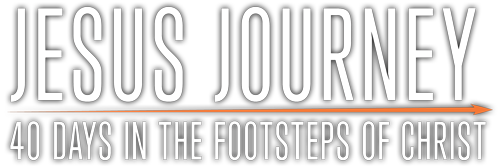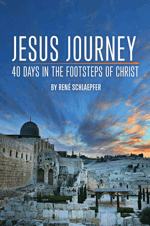Day 32
Not One Stone
Read Mark 13:1–2; Luke 21:5–24
We stop in the cool, dark tunnel beneath the Arab quarter of Jerusalem.
The noisy bustle of the Old City has receded entirely and we hear only the steady drip of water from the tunnel ceiling into an ancient water cistern.
The bearded rabbi leading us through the dimly lit subterranean passage points to the two-thousand-year old retaining wall built by King Herod, and whispers, “We are now as close to the spot of the Holy of Holies as it is possible for any Jew to be.”
He figures we’re about sixty feet from the place on the Temple Mount where the Ark of the Covenant once stood as the seat of the shekinah glory of God.
In this same tunnel, the rabbi points out the largest stone yet discovered in the Temple wall. He says it’s bigger than any building block in any Egyptian or Roman monument, measuring about forty-five yards across and weighing hundreds of tons.
I’m blown away by what’s left of Herod’s Temple, especially when I realize I’m just seeing the remnants of the retaining wall; Jesus’ disciples saw the whole thing near the height of its glory! The Temple was “adorned with beautiful stones and with gifts dedicated to God”
(Luke 21:5). The disciples were impressed with the splendor: “‘Look, Teacher!’ they said to Jesus. ‘What massive stones! What magnificent buildings!’”
(Mark 13:2)
THE MOST BEAUTIFUL BUILDING
By Jesus’ day, the spectacular temple site was nearing completion after forty-six consecutive years of construction. The retaining walls for the platform alone were about 140 feet tall, the height of a modern fourteen-story building; then the porches and other Temple buildings on top were higher still.
It was all covered with gleaming white marble. Gold leaf was layered on the interior — and possibly exterior — Temple walls. Josephus reports that the Temple contained vast wealth, much of it used as decoration, as Jews from all around the world sent money for the construction. In a preview of modern Holy Land tourism, in Jesus’ day vendors sold souvenirs and guides gave tours! 38
Beyond all its beauty, though, it’s difficult for modern Christians to accurately imagine the cultural and theological importance of the Temple to first-century Judaism.
The Temple represented:
The bridge between heaven and earth. God’s presence in the Holy of Holies was not just a metaphor; it was the literal spot where God connected to humanity. He is omnipresent, but this was the place of holy encounter.
The place of God’s presence. Inside the Holy of Holies, the shekinah glory of God appeared.
The visual representation of the character qualities of the invisible God. There were no idols, of course, but the Temple represented the perfection and majesty of God with its impressive decorations and white-robed priests.
The means of atonement. Once a year, the high priest would sacrifice a lamb and then release a scapegoat for the forgiveness of the people’s sins.
The symbol that bound the people together. The traditions and common rituals that connected the followers of the One God from all over the world found their root here. The Temple was the center of life and worship. 39
And then Jesus says, “The day is coming when not one single Temple stone will be left in place.”
Not one stone.
Pretty disconcerting! The Messiah was supposed to purify the Temple, not destroy it — or prophesy its destruction.
The people really do not like this. In fact, this prophecy is misquoted at Christ’s trial as evidence against him:
“We heard him say, ‘I will destroy this temple made with human hands and in three days will build another, not made with hands.’” Mark 14:58
And it was not only offensive talk; it was crazy talk.
By this point, Jerusalem is a big city, it’s on a hill, it’s fortified by thick walls and surrounded by steep ravines — so it’s very defensible. And even if the city was sacked — the idea of the Temple being torn down? Its foundation stones were the size of boxcars. No, what Jesus said was proof he was one sheep short of a flock.
Then of course, Christ’s prophecy is precisely fulfilled about forty years later, on July 9, 70 AD, when Roman soldiers begin to systematically destroy Jerusalem.
Josephus describes the Romans razing the Temple building down past its foundations, all the way to bedrock, literally prying every single stone loose and tossing it to the streets below so that no evidence of it remained.
I saw remnants of this destruction when I walked through archaeological digs around the Temple Mount. It almost looks as though the destruction happened yesterday. Massive pillars and blocks thrown down from the Temple buildings still remain where they crashed into streets below, left as a warning to all who would oppose Rome.
Even before the rebellion, though, Herod’s lavish Temple was beginning to fall apart: Josephus says its foundation had begun to sink dramatically, causing the Temple to crumble. Herod the Great’s grandson Agrippa imported huge timbers from Lebanon, hoping to underpin the sanctuary and raise it up twenty cubits, but the war with Rome stopped his restoration. 40 To me, that’s a metaphor for any legalistic system: Eventually, it sinks under its own weight, sucked under by its own thick fortress walls.
NO MORE TEMPLE
Jesus wasn’t just prophesying the temple’s destruction. He fulfills the role of the temple, in every way:
The bridge between heaven and earth.
The place of God’s presence.
The visual representation of the character qualities of the invisible God. As Jesus said, “If you have seen me, you have seen the Father”
(John 14:9). Want to know what God the Father would do in any situation? Look at Jesus.
The means of atonement.
The symbol that bound the people together.
We no longer need a temple. Not one stone. Except the cornerstone.
Jesus said to them, “Have you never read in the Scriptures: The stone the builders rejected has become the cornerstone;
the Lord has done this, and it is marvelous in our eyes”? Matthew 21:42
IMAGINE THERE’S A HEAVEN WITH NO TEMPLE
Cut to the future: In John’s vision of the perfect Jerusalem in the new heaven and the new earth, there is no temple:
I did not see a temple in the city, because the Lord God Almighty and the Lamb are its temple. Revelation 21:22
This is history coming full circle, the culmination of the story that began at Genesis: In the beginning, we lived in paradise and walked with God. Then there was a separation between God and humanity because of our sin.
We have been longing for reunion with God ever since, a reunion only imperfectly achieved through temples and sacrifices which foreshadow the ultimate solution: the day God himself gives us his shekinah glory permanently, on earth as it is in heaven.
Our lifelong nostalgia, our longing to be reunited with something in the universe from which we now feel cut off …is the truest index of our real situation… The longing to bridge some chasm that yawns between us and reality is part of our inconsolable secret. And surely from this point of view the promise of glory becomes highly relevant to our deepest desire… The door on which we have been knocking all our lives will open at last… At present we are on the outside, on the wrong side of the door… but all the leaves of the New Testament are rustling with the rumor that it will not always be so. — C. S. Lewis 41
Ponder
Jesus fulfills the role of the Temple. What implications does this have for your daily life?

 Buy Jesus Journey at Amazon.com
Buy Jesus Journey at Amazon.com